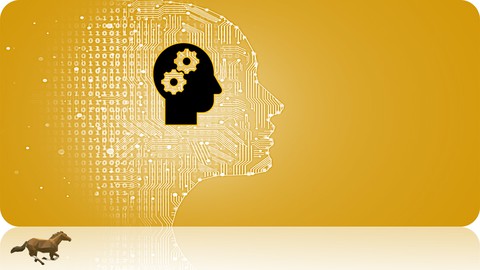
Masterclass of Machine Learning with Python
Masterclass of Machine Learning with Python, available at $19.99, has an average rating of 4.6, with 74 lectures, based on 43 reviews, and has 390 subscribers.
You will learn about The course provides path to start career in Data Science , Artificial Intelligence, Machine Learning Problem Solving Approach Impress interviewers by showing an understanding of the Machine Learning Algorithm concept Python Basic to Advance Concept with Numpy, Pandas, Matplotlib, Seaborn, Plotly Library Scikit Learn Library in Depth Machine Learning Algorithms such as Linear, Logistic, SVM, KNN, K Mean, Naïve Bayes, Decision Tree and Random Forest Machine Learning Types Such as Supervise Learning, Unsupervised Learning, Reinforcement Learning Machine Learning concept such as Train Test Split, Machine Learning Models, Model Evaluation This course is ideal for individuals who are The course is ideal for beginners, as it starts from the fundamentals and gradually builds up your skills in Machine Learning Algorithms or People interested to learn Machine Learning Algorithms using Scikit Learning Library and Python It is particularly useful for The course is ideal for beginners, as it starts from the fundamentals and gradually builds up your skills in Machine Learning Algorithms or People interested to learn Machine Learning Algorithms using Scikit Learning Library and Python.
Enroll now: Masterclass of Machine Learning with Python
Summary
Title: Masterclass of Machine Learning with Python
Price: $19.99
Average Rating: 4.6
Number of Lectures: 74
Number of Published Lectures: 74
Number of Curriculum Items: 74
Number of Published Curriculum Objects: 74
Original Price: ₹999
Quality Status: approved
Status: Live
What You Will Learn
- The course provides path to start career in Data Science , Artificial Intelligence, Machine Learning
- Problem Solving Approach
- Impress interviewers by showing an understanding of the Machine Learning Algorithm concept
- Python Basic to Advance Concept with Numpy, Pandas, Matplotlib, Seaborn, Plotly Library
- Scikit Learn Library in Depth
- Machine Learning Algorithms such as Linear, Logistic, SVM, KNN, K Mean, Naïve Bayes, Decision Tree and Random Forest
- Machine Learning Types Such as Supervise Learning, Unsupervised Learning, Reinforcement Learning
- Machine Learning concept such as Train Test Split, Machine Learning Models, Model Evaluation
Who Should Attend
- The course is ideal for beginners, as it starts from the fundamentals and gradually builds up your skills in Machine Learning Algorithms
- People interested to learn Machine Learning Algorithms using Scikit Learning Library and Python
Target Audiences
- The course is ideal for beginners, as it starts from the fundamentals and gradually builds up your skills in Machine Learning Algorithms
- People interested to learn Machine Learning Algorithms using Scikit Learning Library and Python
This Course will design to understand Machine Learning Algorithms with case Studies using Scikit Learn Library. The Machine Learning Algorithms such as Linear Regression, Logistic Regression, SVM, K Mean, KNN, Naïve Bayes, Decision Tree and Random Forest are covered with case studies using Scikit Learn library. The course provides path to start career in Data Science , Artificial Intelligence, Machine Learning. Machine Learning Types such as Supervise Learning, Unsupervised Learning, Reinforcement Learning are also covered. Machine Learning concept such as Train Test Split, Machine Learning Models, Model Evaluation are also covered.
A subfield of artificial intelligence (AI) and computer science called machine learning focuses on using data and algorithms to simulate how humans learn, gradually increasing the accuracy of the system.
With the use of machine learning (ML), which is a form of artificial intelligence (AI), software programmes can predict outcomes more accurately without having to be explicitly instructed to do so. In order to forecast new output values, machine learning algorithms use historical data as input.
Machine learning is frequently used in recommendation engines. Business process automation (BPA), predictive maintenance, spam filtering, malware threat detection, and fraud detection are a few additional common uses.
Machine learning is significant because it aids in the development of new goods and provides businesses with a picture of trends in consumer behaviour and operational business patterns. A significant portion of the operations of many of today’s top businesses, like Facebook, Google, and Uber, revolve around machine learning. For many businesses, machine learning has emerged as a key competitive differentiation.
Course Curriculum
Chapter 1: Introduction
Lecture 1: Course Overview in Animation
Lecture 2: Why to join this course?
Lecture 3: Meet Trainer for this Course
Lecture 4: Supervise Learning
Chapter 2: Python Tutorial with its Libraries
Lecture 1: Introduction of Python and Python Libraries
Lecture 2: Environment Set up
Lecture 3: Data Type, Variable and Keywords
Lecture 4: how to take input
Lecture 5: How to produce output _ Print Statement in Python
Lecture 6: List, Tuple, Set, Dictionary
Lecture 7: List Operations in details
Lecture 8: Tuple Operations in details
Lecture 9: Set Operations in details
Lecture 10: Dictionary Operations in details
Lecture 11: String Operation in Python
Lecture 12: Data Type Conversion
Lecture 13: Types of Operator
Lecture 14: Math library
Lecture 15: Generation of Random Number and Range Functions
Lecture 16: Importance of Indentation
Lecture 17: Sequential, Selection, Repetition
Lecture 18: Python CSV file Operations
Lecture 19: User Define Functions and inbuilt Function
Lecture 20: Python Crash Course
Lecture 21: Numpy Library Tutorial 1
Lecture 22: Numpy Library Tutorial 2
Lecture 23: Numpy Library Tutorial 3
Lecture 24: Numpy Library Tutorial 4
Lecture 25: Numpy Library Tutorial 5
Lecture 26: Numpy Library Tutorial 6
Lecture 27: Numpy Library Tutorial 7
Lecture 28: Numpy Library Official Site Visit
Lecture 29: Pandas Tutorial 1
Lecture 30: Pandas Tutorial 2
Lecture 31: Pandas Tutorial 3
Lecture 32: Pandas Tutorial 4
Lecture 33: Pandas Tutorial 5
Lecture 34: Pandas Tutorial 6
Lecture 35: Pandas Tutorial 7
Lecture 36: Pandas Tutorial 8
Lecture 37: How to choose the RIGHT Charts & Graph for your Data
Lecture 38: Matplotlib Library Tutorial 1
Lecture 39: Matplotlib Library Tutorial 2
Lecture 40: Matplotlib Library Tutorial 3
Lecture 41: Matplotlib Library Tutorial 4
Lecture 42: Matplotlib Library Official Site Visit
Lecture 43: Seaborn Library Tutorial 1
Lecture 44: Seaborn Library Tutorial 2
Lecture 45: Seaborn Library Official Site Visit
Lecture 46: Plotly Library Tutorial
Chapter 3: Different Sources for Dataset
Lecture 1: Different Sources for Dataset
Chapter 4: Advance Statistics Technique using Excel
Lecture 1: When to Use Which statistical Method
Lecture 2: T Test and Z Test
Lecture 3: Chi Square
Lecture 4: Anova
Chapter 5: Machine Learning Foundation
Lecture 1: Training, Testing and Model Evaluation in Machine Learning
Lecture 2: Unsupervised Learning
Lecture 3: Reinforcement Learning
Lecture 4: Confusion Matrix
Lecture 5: Dimension Reduction is Curse in Machine Learning
Lecture 6: Reasons to Learn Probability for Machine Learning
Lecture 7: Data Science Introduction
Lecture 8: Steps to Start Project in Data Science with Machine Learning
Lecture 9: Case Study of Titanic Dataset
Lecture 10: Case Study of Suicides in India 2001-2012
Lecture 11: Case Study on Google Review using various different plot using Matplotlib
Chapter 6: Machine Learning Algorithms
Lecture 1: Linear Regression
Lecture 2: Logistic Regression
Lecture 3: Support Vector Machines (SVM)
Lecture 4: Support Vector Machines (SVM)
Lecture 5: K Mean Algorithm
Lecture 6: KNN Algorithm
Chapter 7: Complete Guide to Scikit Learn Library with Case Study on Diabetes Dataset
Lecture 1: Case Study
Chapter 8: Complete Guide to Scikit Learn Library with Case Study on Titanic Dataset
Lecture 1: Case Study
Instructors
-
Piyushh n Dave9
Professional Trainer of Python, Data Science, AI, ML, DL
Rating Distribution
- 1 stars: 1 votes
- 2 stars: 0 votes
- 3 stars: 2 votes
- 4 stars: 6 votes
- 5 stars: 34 votes
Frequently Asked Questions
How long do I have access to the course materials?
You can view and review the lecture materials indefinitely, like an on-demand channel.
Can I take my courses with me wherever I go?
Definitely! If you have an internet connection, courses on Udemy are available on any device at any time. If you don’t have an internet connection, some instructors also let their students download course lectures. That’s up to the instructor though, so make sure you get on their good side!
You may also like
- Best Yoga Instruction Courses to Learn in March 2025
- Best Stress Management Courses to Learn in March 2025
- Best Mindfulness Meditation Courses to Learn in March 2025
- Best Life Coaching Courses to Learn in March 2025
- Best Career Development Courses to Learn in March 2025
- Best Relationship Building Courses to Learn in March 2025
- Best Parenting Skills Courses to Learn in March 2025
- Best Home Improvement Courses to Learn in March 2025
- Best Gardening Courses to Learn in March 2025
- Best Sewing And Knitting Courses to Learn in March 2025
- Best Interior Design Courses to Learn in March 2025
- Best Writing Courses Courses to Learn in March 2025
- Best Storytelling Courses to Learn in March 2025
- Best Creativity Workshops Courses to Learn in March 2025
- Best Resilience Training Courses to Learn in March 2025
- Best Emotional Intelligence Courses to Learn in March 2025
- Best Time Management Courses to Learn in March 2025
- Best Remote Work Strategies Courses to Learn in March 2025
- Best Freelancing Courses to Learn in March 2025
- Best E-commerce Strategies Courses to Learn in March 2025






















